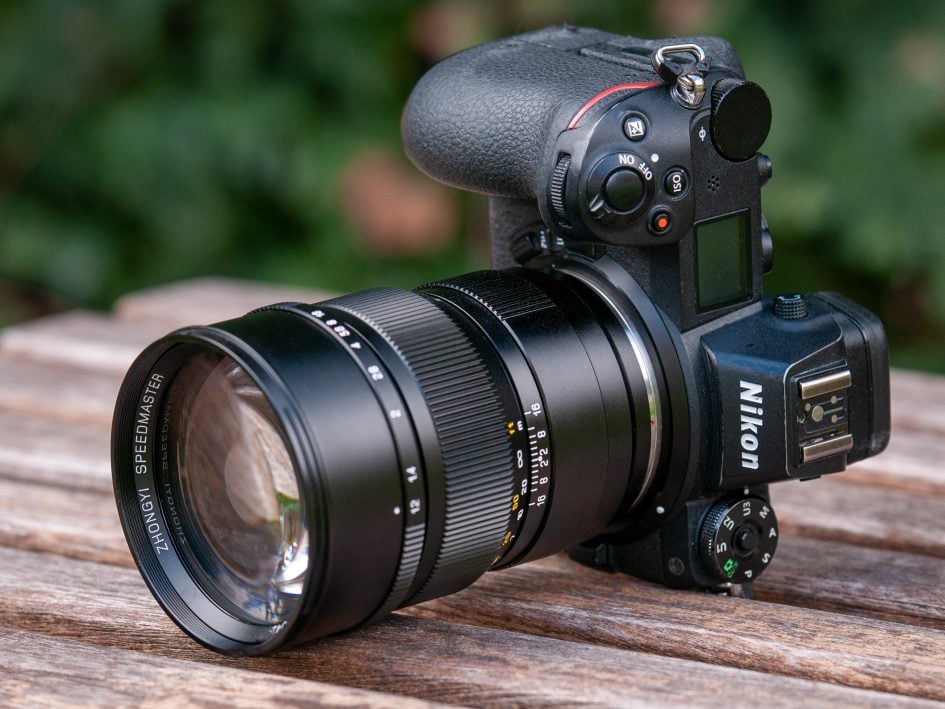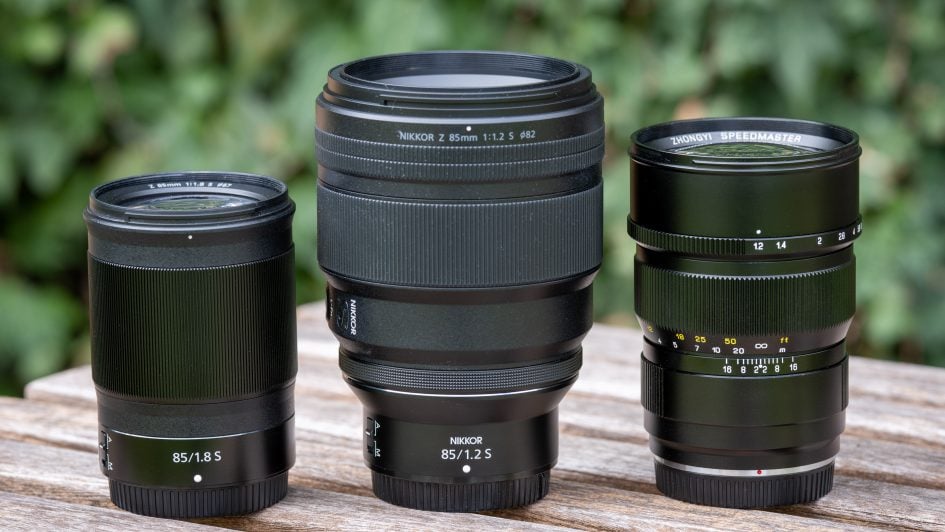Zhongyi Mitakon Speedmaster 85mm f1.2 review
-
-
Written by Thomas
Intro
The Zhongyi Mitakon Speedmaster 85mm f1.2 (“Mitakon 85mm f1.2” for short) was originally launched in 2017 for Nikon and Canon DSLRs. Since then Zhongyi added versions for Sony’s A- and E-mount, Fujifilm G-mount, Pentax K-mount as well as Canon’s RF and Nikon’s Z mirrorless mounts, and it’s the latter I’ve tested for this review.
The lens is manual focus and manual aperture only and does not have electrical contacts to communicate EXIF data to the camera body. But then it costs less than a quarter of Nikon’s or Canon’s 85mm f1.2 lenses and is smaller and lighter to boot. With its bright focal ratio of f1.2 the Mitakon gathers a bit over two times the light of f1.8 lenses and allows for good background isolation and blur – hopefully with a smooth Bokeh.
The Mitakon 85mm f1.2 is made in China and listed at around 500 EUR/USD/GBP – depending on the mount. PS – if you’re interested in another ultra-bright Mitakon Speedmaster lens check out my in-depth Zhongyi Mitakon Speedmaster 50mm f0.95 III review.
Facts and features
Let’s compare the Mitakon 85mm f1.2 to Nikon’s Z 85mm f1.2 S and Z 85mm f1.8 S, the Viltrox AF 85mm f1.8 II, Sigma Art 85mm f1.4 HSM (which can still be used via adapter), Canon’s RF 85mm f1.2 L USM, and Sony’s FE 85mm f1.4 GM. As usual I’ve rated the features with a [+] (or [++]), when it’s better than average or even state of the art, a [0] if it’s standard or just average, and [-] if there’s a disadvantage.
Size (Z-mount version, diameter x length): 83 x 117mm (3.3 x 4.6in.) plus 51mm for the lens hood (102mm diameter) which makes the Mitakon much slimmer than Canon’s RF 85mm f1.2 L USM (103 x 117mm + lens hood) or Nikon’s Z 85mm f1.2 S (103 x 142mm + 65mm lens hood) and more comparable to Sony’s FE 85mm f1.4 GM (90 x 108mm + 42mm lens hood). The Nikon Z 85mm f1.8 S and the Viltrox are much smaller while the Sigma Art is 95 x 123mm + 53mm lens hood + 31mm for the FTZ adapter. So the Mitakon is not a small lens but its girth is pretty normal which makes handling and especially mounting the lens much less daunting than with the f1.2 lenses from Canon or Nikon. [0]
Weight (Z-mount version): At 955g (33.7 oz.) plus 45g for the lens hood the Mitakon seems on the pretty heavy side but it is in fact 200-300g lighter than Canon’s or Nikon’s f1.2 lenses and only around 100g heavier than the Sony FE 85mm f1.4 GM. Both f1.8 lenses from Nikon and Viltrox are (naturally) much lighter at around 500g while the Sigma Art 85mm f1.4 HSM is 1113g + 51g lens hood + 133g for the FTZ adapter. [+]
Optics: The Mitakon has 9 elements in 6 groups and (like the Sigma) is a DSLR design. Zhongyi simply adapts to the different flange distances of DSLR and mirrorless cameras by varying the length of the barrel. The other lenses in this comparison have more complex designs which were specifically developed for mirrorless cameras. [+]
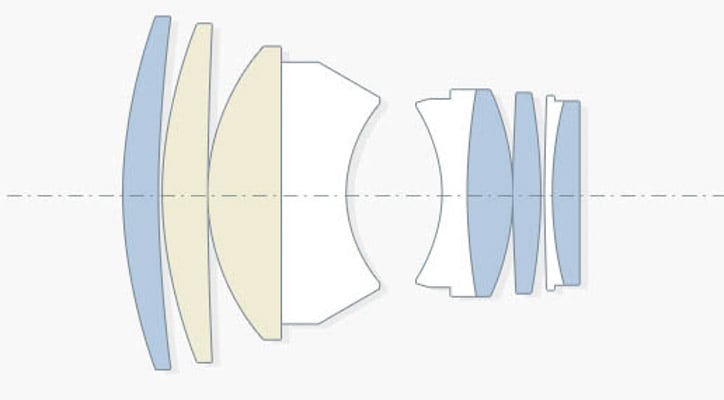
Minimum object distance / maximum magnification: The Mitakon cannot achieve a higher magnification than 1:10.2 at its MOD of 1.05m. But the other lenses in this comparison are not much better: They achieve maximum magnifications of around 1:8 – 1:7. [0]
Filter-thread: 77mm, like the Sony. Both f1.2 lenses from Canon and Nikon need 82mm filters, the Sigma even 87mm. The Z 85mm f1.8 S needs 67mm, the Viltrox 72mm filters. [+]
Image stabilization: None of the lenses in this comparison offers optical stabilization. But modern mirrorless bodies often provide built-in sensor-shift stabilization. To make this work (on a Nikon full-frame body) you need to enter the focal length – otherwise stabilization cannot be switched on. [0]
Auto focus: No, the Mitakon is the only lens in this comparison without AF. [-]
Aperture ring and other control elements: The Mitakon has an aperture and a focus ring but no other control elements. The aperture ring has no clicks to indicate f-stops and the angle of rotation between f-stops is large at the beginning but becomes progressively narrower towards f16. Of the other lenses in this comparison only the Sony offers a dedicated aperture ring while most of the others (except for the Sigma) have a control ring which can be assigned different functions (including aperture). [+]
Lens profile: The Mitakon does not have a lens profile in camera but Adobe’s RAW converter supplies one correcting distortions and vignetting: Just look under the Brand “ZY Optics”. If you’re shooting JPGs you have to dial in corrections manually. [0]
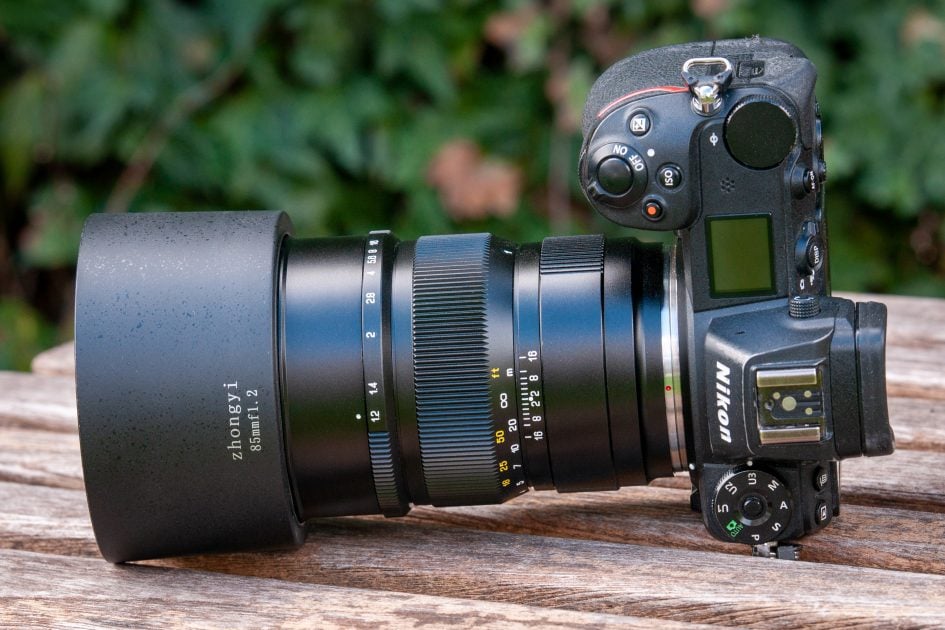
Covers full frame/FX or smaller. Just like all other lenses in this comparison. [+]
Price: 500 EUR (incl. 19% VAT)/USD/GBP. The Nikon Z 85mm f1.2 is 3349 EUR / 2797 USD / 2999 GBP, the Canon RF 85mm f1.2 L USM is 3200 EUR / 2600 USD / 3060 GBP, and the Sony FE 85mm f1.4 GM sells at 1500 EUR / 1800 USD / 1500 GBP. The Z 85mm f1.8 S is 830 EUR / 800 USD / 770 GBP, the Viltrox AF 85mm f1.8 II is 370 EUR / 400 USD / 340 GBP, the Sigma Art 85mm f1.4 HSM is 1100 EUR / 1200 USD / 930 GBP (plus needs an FTZ adapter). [+]
The lens comes without a pouch but the lens hood is included plus is reversible for transport. Unfortunately mounting the lens hood is quite an act and it needed quite some force to mount/unmount it. [0]
Sealing: there’s no sealing at all on the Mitakon, neither on the lens mount nor at the various rotating parts of the barrel. [-]
At 2[-]/5[0]/6[+] the score in the “features-department” of the Mitakon 85mm f1.2 is a bit mixed: The most important property of this lens certainly is the very bright focal ratio of f1.2 which gathers a bit over one stop more light than f1.8 lenses which lets you shoot at shorter shutter speeds and/or lower ISO and also gives better subject isolation and – hopefully – a better Bokeh too. Combined with a very low price and an acceptable size and weight the lens could have scored higher were it not for the complete absence of weather sealing and – more importantly – autofocus, electrical aperture actuation, or EXIF data.
Above from left to right: Nikon Z 85mm f1.8 S, Z 85mm f1.2 S, Zhongyi Mitakon 85mm f1.2
Focus
As with all manual focus lenses I can only say: if you can’t manage to properly focus manually you better forget about this lens – and at f1.2 that is an even more daunting task. Because although modern mirrorless cameras offer a lot of features to support accurate manual focusing it is still a challenge when trying to focus on non-static subjects: With the shallow depth of field of the Mitakon at large apertures you need to constantly adjust focus – or your shooting posture. Just an example: When shooting a head & shoulders portrait at 1.6m distance depth of field is less than 2.5 cm (1 in.) when calculated with a circle of confusion of 0.029mm (6 pixels wide). If you have stricter demands for perfect sharpness dof easily shrinks to 1cm and less. And there’s another reason I found focusing wide open a bit difficult: The lens is relatively soft wide open from residual spherical aberrations so it does not exactly “snap” into focus (see also the loCA test-shots on the next page). Especially problematic is focusing outside the center – think the eye of a model – where the Mitakon is even less sharp. I often found myself focusing at f2.0 where the lens is much sharper and then open the aperture to f1.2.
The focus ring is 28mm wide and has no slack/play between its movement and the focus-action and a long throw of 270 degrees which makes it easy to adjust focus in small increments. At the minimum object distance of 1.05m the barrel of the lens extends 13mm over the retracted status at infinity. There is a hard stop at infinity which caused problems – at least with my copy of the lens: See my remarks in the chapter on performance at long distances on the next page. The surface of the focus ring is rubberized, rotation is quite stiff and becomes even stiffer in cold temperatures. The aperture ring is especially stiff and there’s a risk of inadvertently moving focus when you operate the aperture ring.
As you pull focus, you’ll notice strong focus breathing: When I adjusted the focus from infinity to 1.05m on the Mitakon 85mm f1.2 I measured a 16% increase in magnification. This is quite distracting when shooting videos.
Next check out my quality results!
Check prices on the Zhongyi Mitakon Speedmaster 85mm f1.2 at B&H or Adorama. Alternatively get yourself a copy of my In Camera book, an official Cameralabs T-shirt or mug, or treat me to a coffee! Thanks!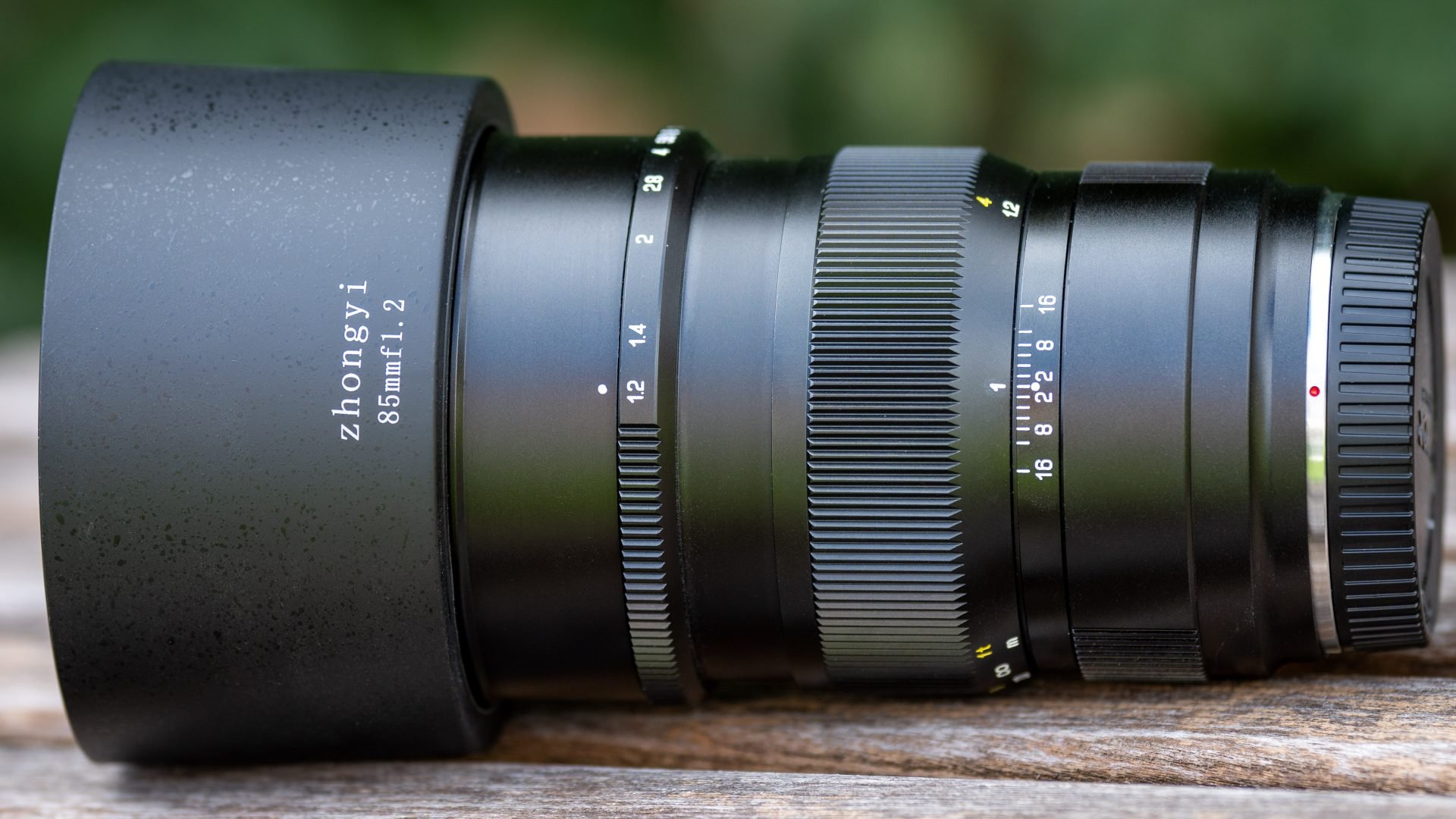
 The manual focus Zhongyi Mitakon Speedmaster 85mm f1.2 is one of only a few 85mm f1.2 lenses available, and at around 500 EUR/USD/GBP pretty cheap too. Its background Bokeh wide open is heavily blurred (although not very smooth) and the lens produces a very shallow depth of field. Available in Sony E, Canon RF and Nikon Z-Mounts, it does not attain the optical heights of the considerably more expensive alternatives from Nikon or Canon as it has loads of optical aberrations: Astigmatism, field-curvature, spherical aberrations, purple fringing, and very low resistance against flare and glare especially wide open. But if you're into portraiture those flaws might well be acceptable - provided you know how to precisely nail focus manually. With this caveat in mind I can still recommend the Mitakon 85mm f1.2 for the money, but bargain hunters may also want to consider adapting a used Canon EF 85mm f1.2L for which has the benefit of autofocus for a couple hundred more.
The manual focus Zhongyi Mitakon Speedmaster 85mm f1.2 is one of only a few 85mm f1.2 lenses available, and at around 500 EUR/USD/GBP pretty cheap too. Its background Bokeh wide open is heavily blurred (although not very smooth) and the lens produces a very shallow depth of field. Available in Sony E, Canon RF and Nikon Z-Mounts, it does not attain the optical heights of the considerably more expensive alternatives from Nikon or Canon as it has loads of optical aberrations: Astigmatism, field-curvature, spherical aberrations, purple fringing, and very low resistance against flare and glare especially wide open. But if you're into portraiture those flaws might well be acceptable - provided you know how to precisely nail focus manually. With this caveat in mind I can still recommend the Mitakon 85mm f1.2 for the money, but bargain hunters may also want to consider adapting a used Canon EF 85mm f1.2L for which has the benefit of autofocus for a couple hundred more.